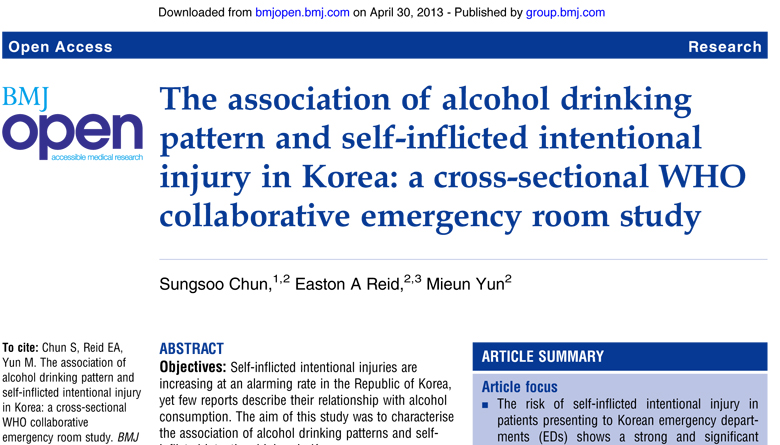|
BMJ_ A Cross-sectional WHO collaborative emergency room study
|

Objectives: Self-inflicted intentional injuries are increasing at an alarming rate in the Republic of Korea,
yet few reports describe their relationship with alcohol consumption. The aim of this study was to characterise
the association of alcohol drinking patterns and selfinflicted intentional injury in Korean emergency
departments (EDs) using WHO collaborative study protocol.
Design: Cross-sectional study.
Setting: Data were collected from four general hospital EDs in four geographically diverse regions of
Korea: Seoul, Suwon, Chuncheon and Gwangju.
Participants: Information was collected on 1989 patients aged 18 and above. A representative
probability sample was drawn from patients admitted to each ED for the first time within 6 h of injury.
Primary and secondary outcome measures:
Alcohol-related non-fatal injuries.
injuries and 137 (29.3%) were intentional injuries
caused by someone else. The adjusted odds of selfinflicted intentional injury verses unintentional injury
were calculated for heavy (OR 1.764; 95% CI 0.783to 3.976), binge (OR 2.125; 95% CI 0.930 to 4.858)
and moderate drinking (OR 3.039; 95% CI 1.129 to 8.178) after controlling for demographic variables.
Similar odds were reported for pooled intentional injury data (self-inflicted and caused by someone else) and
drinking patterns.
Conclusions: These data show a strong association between all patterns of acute alcohol consumption and
self-inflicted intentional injury in the Republic of Korea.![]() Cross-sectional_WHO_collaborative_emergency_room_study__BMJ_.pdf (196.0K) Download count:90
Cross-sectional_WHO_collaborative_emergency_room_study__BMJ_.pdf (196.0K) Download count:90


